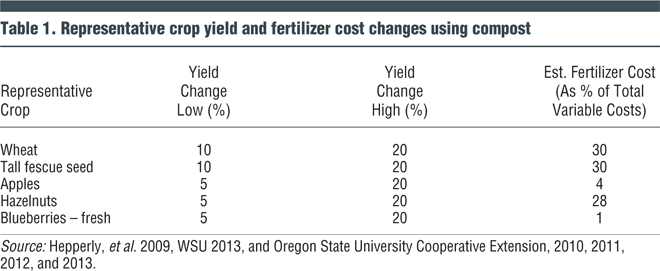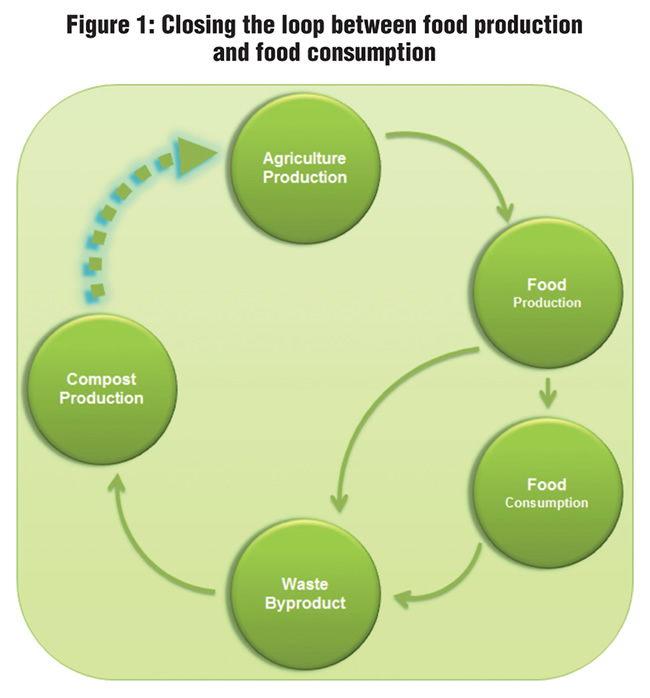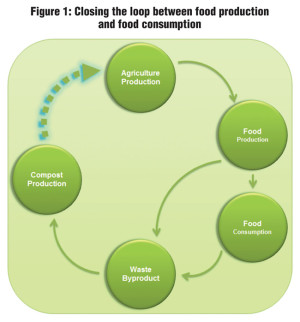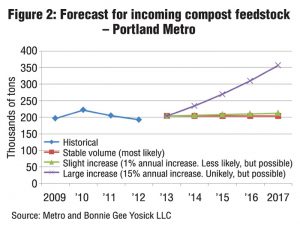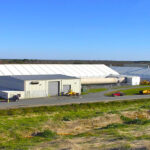Economic analysis of compost supply, demand and utilization involved gathering data from various sources, including agricultural extension services, Metro and interviews with composters and farmers.
Jeri Sawyer, Bonnie Gee Yosick and Erin Harwood
BioCycle March/April 2015
How can a region help farmers overcome barriers to compost use? And can locally-generated feedstocks meet crop nutritional needs? These and others are questions posed by Metro Regional Government in Portland, Oregon (Metro), in their quest to close the loop between food production and food consumption (Figure 1). ENVIRON International Corporation, Bonnie Gee Yosick, LLC, and EA Consulting teamed up to explore the answers to these questions in a report that is summarized in this article.
This study involved gathering data from various sources including agricultural extension services, Metro, and composters and farmers. The ENVIRON team conducted interviews with eight Metro region compost producers to acquire nutrient data and market indicators. Several local farmers were also interviewed regarding compost use-or nonuse on their farms. Economic assessments were conducted where data were available, with the intent to evaluate how Metro might attain its goal of closing or narrowing the loop between food production and consumption.
Farmer Demand For Compost
Many factors influence farmers’ decisions about whether or not to use compost. In general, the answer depends on a host of farm-specific attributes. Some overarching themes include farmer perceptions, compost quality concerns and the economic feasibility of compost use.
Farmer Perceptions
Farmers appear to have proficient knowledge about using compost, as well as the benefits associated with its use. Many are also aware that it will not provide the sole source of nutrients for their crop needs (WSU 2013). They also recognize the need to combine information from recent soil tests and nutrient analyses of the composts, with the needs of the crops they are growing. However, farmers are also influenced by their experiences, peer experiences, crop types grown, and resources specific to their own operations.
Farmers interviewed in the Portland Metro area viewed compost as a long-term investment in overall soil quality, rather than an annual source of nutrients. Several noted that they felt compost was a product that was applied to plots that were being newly established to build and increase overall soil organic matter. They felt that after a certain point, adding compost was not worth the resources required to apply it, mainly because additional organic matter is not as useful in crop production as soil nutrient levels.
Compost Quality Needs
The nutrient value of food waste compost is in part a function of the varying incoming feedstocks, which fluctuate on a seasonal basis. The incoming feedstock mix, time of year, screening size, and many other factors may cause the nutrient value of compost to vary significantly.
The two key factors of compost nutrient quality include 1) the nitrogen, phosphorus, and potassium ratio (N:P:K) and 2) the carbon to nitrogen ratio (C:N). The ratio presented for N:P:K is the concentration, as a percentage, of the nutrient within the fertilizer or compost. Based on the interviews, regional composts have an N:P:K ratio of about 2:1:1. Pure local yard debris composts tend to have less nitrogen and can have an N:P:K ratio closer to 1:1:1. For comparison, packaged compost for vegetable gardens usually has a ratio of 4:3:3, with the higher nitrogen concentrations needed for fast growth. The nutrient needs of perennials such as fruits and berries are spread out over a longer time span, and are lower over the short term.
Carbon provides a source of soil organic matter, which improves overall soil health. However, C:N ratios greater than 20:1 may lead to soil nitrogen loss, which can negatively impact crop growth and final yields. Local compost C:N ratios tend to be less than 20:1 and will provide a source of slow release nitrogen over a longer period, which is preferable for perennial crops.
Another factor influencing the quality of compost needed in agriculture is grain size of the product. In general, larger screened materials are better utilized as mulch for weed deterrent and soil water-retention uses. Smaller screened materials are better used for direct application to mixed vegetable crops and similar types of food crops. The latter provides easier and quicker application of compost material to a large area, and therefore a significant decrease in overall resources used in the application process.
Alternative Fertilizers (Compost Substitutes)
In general, demand is driven by price of the product and the price of substitute or alternative products. As a rule, demand will increase as price decreases and as the price of a substitute product increases. Farmers are highly conscious of costs of products other than compost that they might use to provide fertilizer value to their soil and crops. One substitute for compost is use of a cover crop. The “price” or cost of cover crops includes not only total cost to produce the cover crop but also the opportunity costs of otherwise using the land.
Among those farmers interviewed, there was some difference in views between the benefits to be gained in nutrients from compost versus the use of cover crops. The latter, often called green manure, can provide a source of nutrients and soil protection, while also allowing a field to lay fallow and rest between crop rotations. Composts and cover crops can be utilized together; however farmers typically prefer one over the other, often due to resource limitations in their operations.
An additional substitute product for some farmers is liquid manure fertilizer, available from organic dairies at very little or no cost. This product has lower resource inputs for application (time, gas, tractor use, direct cost of material) and also allows farmers to meet organic standards. Further, this product provides the organic dairies with an outlet for a by-product they can no longer apply to their pastures due to nitrogen concentrations within their soils.
One farmer interviewed noted that he creates his own on-farm compost in an effort to manage the challenges associated with using compost. By utilizing crop residue wastes, livestock manure, and other feedstocks, he can create a consistent product with known components, reduce potential contaminants, and also have the compost readily available on the farm whenever he is ready to utilize it (Olsen, 2014).
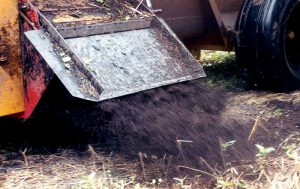
One barrier to compost use by farmers is a lack of equipment to apply compost to their fields or crops.
Photo courtesy of Florida Research Center for Agricultural Sustainability, Inc.
Other Costs
Transporting materials to the farm from the compost production area adds increased cost and time to farmers who seek to use compost on their farms. Any additional delivery charge to the farmer increases the cost of compost. Farmers must also mix additional fertilizer materials into the compost to meet basic crop needs, requiring additional time for both mixing the materials together, and for application. Most liquid fertilizers can be applied quickly and easily to fields, while compost requires different equipment (usually a spreader) and takes much longer to apply.
Fixed costs include equipment, storage, and other investments that are not part of regular monthly expenditures. The rate at which fixed costs can be recovered depends on the change in profit from switching to compost. Storage facilities will be required for all enterprises using compost, but equipment needs may vary between crop type, size of farm, and other factors.
Equipment needs for apple orchard production are provided here as an example. Additional equipment that may be needed (although some enterprises may already use some of them) for orchard site preparation include a subsoiler, which makes a furrow along the tree row, and a mulch/compost spreader for the application of the recommended compost along the tree rows. The spreader can also be used in apple production to reapply mulch about every two years, but also can be used to apply compost (Berkett et. al., 2012). Costs of commercial-grade subsoilers can range in price from $30,000 to $90,000 (Fastline, 2014). Mulch/compost spreaders are estimated to cost between $10,000 and $20,000 (Yakaz, 2014). Storage facilities will vary significantly in cost due to size of farm and crop type. This study assumes a rough estimate of $5,000 to $20,000 (Growers Supply 2014), bringing the total additional fixed costs for an apple orchard to convert to compost use from synthetic fertilizer to a broad range of $45,000 to $130,000. Amortizing over 10 years at an interest rate of seven percent results in an annual cost of $6,400 to $18,500.
Price
Compost prices to farmers can vary significantly between suppliers. The cost for compost (in addition to the other expenses just outlined) may be justified through the potential to increase yields. For this study a low price of $10/cubic yard (cy) and a high price of $25/cy are assumed, as compost producers were reluctant to share detailed information about the prices they charge.
Using the results found in Hepperly, et al. (2009) and WSU (2013), the difference in yield from utilizing compost compared to manure for fruit crops are estimated between 5 and 20 percent, and 10 and 20 percent for grains. Costs are especially difficult to estimate due to the crop-specific and soil-specific requirements related to the compost amendments needed. The quantity of other materials that would need to be added depends on several key factors including: Soil fertility of each individual farm, which could be determined via soil sampling and testing; type of crops the farmer is growing; and type of material being added (e.g., manure, fish compost, or synthetic fertilizers). The type of additional material will thus influence the quantity, and impact the overall cost, in relation to utilizing the compost alone.
Based on the available information, the increase in yields (and therefore increase in revenues) is compared with overall fertilizer costs for representative crops in Table 1. This study limited the analysis of yield change to compost and not the alternatives. Thus the estimated fertilizer cost (as a share of total production cost) in Table 1 has not been associated with any specific change in yield.
It is not clear whether costs would increase or decrease with the use of a compost mix, as the costs and requirements vary widely between crops and throughout the region. However, based on the WSU study (WSU 2013), farmers are willing to pay only $4/cy of compost and the regional compost costs are between two and five times that amount. Therefore, an assumption of increased costs for the majority of farmers would be reasonable. The magnitude is unknown, but using the information provided in Table 1, apples and blueberries may be best able to absorb increases in costs, since fertilizer costs are such a small share of variable costs, and yield increases are estimated between five and 20 percent. Wheat and fescue appear least likely to absorb a cost increase, with fertilizer costs comprising a full 30 percent of variable costs, although yields could increase between 10 and 20 percent.
Feedstock Supply, Compost Production
Feedstock Supply
Data (2012) from Metro indicate nearly 200,000 tons of aggregated incoming material in the forms of compacted yard debris (>50%), green wood chips and leaves, and very small amounts as dry wood, chips and dry sawdust. Food waste is a slowly growing component of compost feedstock due to Metro’s new curbside program, but because it is not consistently available to all composters in the region.
A review of the local compost analyses suggests that the nutrient ratios (N:P:K and C:N) found in local composts do match compost application appropriate for farming within northwest Oregon, but are not sufficient to meet the needs of local annual crops without using additional nutrients. According to Sullivan et al. (2003), “Usually, composts supply only a part of the N needed to produce high-yielding crops; fertilizer N application is needed for maximum crop yields.” Thus, the compost produced in the Metro region could provide a source of nutrients for high yield crops, such as vegetables, which require a higher concentration of N. However, additional amendments will be needed to maintain crop yield at expected levels.
Compost Feedstock And Production Forecasts
The ENVIRON team conducted telephone interviews with eight compost producers (five food waste and three yard debris) about their expansion and development plans. Although producers were interested in expanding, none had any specific plans to expand at the time of the interview. Further, producers were reluctant to share market information such as the prices charged for different composts. Given the current volume of aggregated feedstocks, it seems reasonable to assume that the volume of material would remain relatively constant at that same volume in the near future. It is possible that the volume of compost production could increase somewhat if certain elements were in place. First, there would need to be an increased outreach effort for collection; and second, one or more producers would need to make an investment in capital equipment that would allow them to accept and process more material.
Additionally, consistent quantities of food waste feedstocks would enable some compost producers to expand their production, and provide product to interested farmers who have not been customers in the past. Better connections among farmers and compost producers in near proximity could also assist compost producers in expansion plans. As composters have more customers and demand for their products, their expansion plans would have support for implementation.
Though Metro agrees that the stable volume is the most likely scenario, it was requested that we consider a moderate growth scenario, due to additional commercial and residential composting (one percent annual increase) and a high growth scenario, based on a potential, but unlikely policy shift involving the introduction of a commercial organics disposal ban. Such a ban might result in a significant increase in composting (15 percent annual increase). These scenarios are outlined in Table 2. The results of these projected increases are shown in Figure 2.
Obstacles
The only market-price incentive that may be relevant to farmers who have not historically used compost to begin using compost is the difference between organic and conventional product prices. However, based on the interviews conducted with farmers, considerations of converting from a conventional practice to organic do not include using compost. Some farmers are concerned about pesticide residues from yard debris and feel uncomfortable utilizing yard debris compost on their organic farms, because compost producers have little to no control over incoming in yard debris streams. Further, there is concern about oil and gas residue on leaf litter picked up from streets in Portland and surrounding areas.
The main obstacle to farmers increasing use of compost is that the compost produced within the region will not provide the sole source of nutrients required for most crops grown in the region. It will require mixing with other soil amendments, and the specific ratio would vary based on the crop type, the individual farm soil, as well as other considerations. This issue should receive further study.
On the demand side, several other barriers exist that will need to be addressed to increase compost use for food production, through both education and product modification. Barriers to compost use by farmers include lack of equipment and resources to apply compost (primarily time). Farmers are also highly concerned about contamination issues (heavy metals, pesticides, trash). Metro could investigate certification of finished compost by the Organic Materials Review Institute (OMRI), if feasible, and work with select compost producers to complete the certification process.
Recommendations
Several incentives have been identified that might assist farmers in transitioning to utilizing more compost. These include:
• Create partnerships in research and demonstration trials between Oregon State University (OSU) and OSU Extension faculty, compost producers, and farmers.
• Work with compost producers to ensure a consistent quality product that farmers can readily and easily use. This element will require careful monitoring of contaminants, and product testing in addition to that done through the US Composting Council.
• Work with compost producers to offer delivery options to farmers.
Farmers are interested in utilizing compost, if they can be provided a consistent, contaminant-free, and cost-effective source of material. Farmers are highly responsive to word-of-mouth information, so as more farmers include compost in their crop production, word will spread, as will legitimacy. Metro might consider partnering with OSU, Pacific University, and a few farmers and compost producers to do some “case studies” on compost benefits locally.
Metro might also consider investing in equipment to assist compost producers in amending their finished composts with fish or manure, and then marketing those finished products as being amended and more nutritionally complete, requiring no additional amendment by the farmer prior to application.
Jeri Sawyer is with ENVIRON International Corp., Bonnie Gee Yosick is principal of Bonnie Gee Yosick, LLC and Erin Harwood is with EA Consulting.
